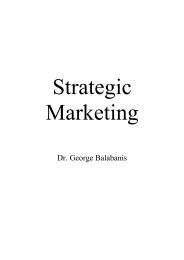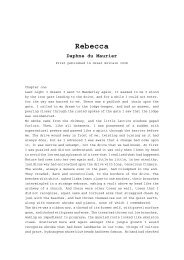Brand Failures
Brand Failures
Brand Failures
Create successful ePaper yourself
Turn your PDF publications into a flip-book with our unique Google optimized e-Paper software.
92 <strong>Brand</strong> failures<br />
of one core brand. (Incidentally, this theory explains why Diet Coke succeeded<br />
where New Coke failed. Whereas the former had supplemented the<br />
original brand, the latter had eradicated it completely.)<br />
In 1996 Miller decided to address this situation, adding yet another brand<br />
to the mix, Miller Regular. The company had looked at the success of its<br />
rivals’ regular beers and wanted a piece of the action. In other words, they<br />
wanted a beer which would come to represent everything Miller stood for,<br />
which by that point was rather a lot.<br />
The only problem was that with so many Miller brands already out there,<br />
launching another one (even with a US $50 million marketing budget) was<br />
always going to be a challenge, especially when it had such an unassuming<br />
name. With an apparently limitless array of Millers to choose from, most<br />
people assumed that Miller Regular had always been there. As a result, the<br />
brand failed to make an impact and Miller eventually decided to withdraw<br />
it altogether.<br />
The problem of identity, however, still remained. Whereas drinkers could<br />
go into a bar and say to the bartender, ‘I’ll have a Budweiser,’ causing little<br />
confusion, if they said, ‘I’ll have a Miller,’ the bartender would inevitably ask,<br />
‘Which Miller’<br />
As Jack Trout wrote in his excellent and influential book, The New<br />
Positioning, ‘the more variations you attach to the brand, the more the mind<br />
loses focus.’ Miller hadn’t just alienated its core customers, it had completely<br />
baffled them. Whereas in the 1970s Miller had achieved its success by<br />
tightening its focus, by the time the company had reached the new millennium<br />
it had broadened itself beyond recognition.<br />
While Miller’s long-standing rival, Budweiser, has now taken its regular<br />
brand identity to new levels of simplicity (reflected in the one-word strap line,<br />
‘True’), Miller still suffers from a lack of coherence. So, although the beer<br />
itself may taste great, the brand has definitely become watered down.<br />
Lessons from Miller<br />
Don’t extend your brand too far. ‘Leverage is good, too much leverage is<br />
bad,’ says brand guru Tom Peters. He is joined in this opinion by Al Ries<br />
and Jack Trout, for whom ‘The Law of Line Extension’ is one of ‘The 22<br />
Immutable Laws of Marketing.’ This law states, ‘if you want to be<br />
successful today, you have to narrow the focus in order to build a position<br />
in the prospect’s mind.’










